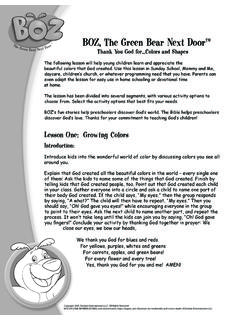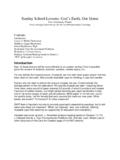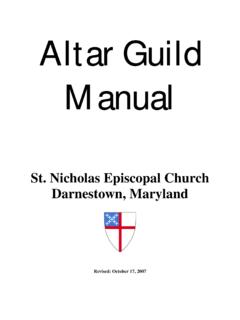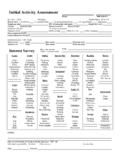Transcription of Mammal Bible - Health and Safety Executive
1 Mammal Bible Report to: Mr. M. Clook Ecotoxicology Section Pesticides Safety Directorate Mallard House, Kings Pool 3 Peasholme Green York YO1 2PX CSL Contract Manager: Dr. Hart Central Science Laboratory Sand Hutton York YO41 1LZ Date of issue of report: November 1998 1998 Update CONTRACT PN0910/PN0919 MILESTONE REPORT Mammals and farming: information for risk assessment Gurney, J.
2 Perrett Crocker & Pascual CSL Project No. M37 2 Contents INTRODUCTION 3 GENERAL ECOLOGICAL INFORMATION (30 SPECIES IN ALPHABETICAL ORDER) 6 DETAILED DIETARY INFORMATION (30 SPECIES IN ALPHABETICAL ORDER) 51 BIBLIOGRAPHY 207 APPENDIX: EXAMPLES OF RESULTS GENERATED BY ACCESS QUERIES 219 3 Introduction This compendium is intended as a companion volume to the earlier volume Birds and farming (Buxton and Crocker, 1996).
3 It has two broad purposes. Firstly it is intended to suggest which Mammal species are most likely to be exposed to particular plant protection products. Thus information has been collected on geographical distribution of mammals on farmland, their typical feeding and breeding habitats, known associations with crops, the times of year when young are being reared, and on population status and trends. Secondly, it is intended to help calculate the likely degree to which a given species may be exposed to a given plant protection product.
4 Using data on pesticide residues found on different food types, the likely exposure of an individual may be calculated -- either directly from data in the review giving actual daily weights of foods eaten; or indirectly by using an species body mass to estimate total daily food requirement and then using data on the proportion of the diet made up by a given food type. The data collected in the course of the review have been stored on a Microsoft Access database. This greatly increases their usefulness by allowing questions to be asked of the database.
5 Thus it is a relatively simple matter to provide lists of species associated with particular habitat, crops, or foods. It may be useful to identify early or late-breeding mammals, small mammals, mammals in decline and so on. More complex queries may also be posed such as: which mammals weighing less than 500g, known to be declining in numbers, are also known to have a preference for a particular farming habitat? Some examples of the tables that may be produced using Access queries are included in the Appendix.
6 In this edition of the compendium we have drawn on additional material collected in project PN09019 Improving estimates of the exposure of non-target wildlife to pesticides in arable crops- a review of existing data. Reflecting the dual function, the compendium is in two parts. 1 General Ecological Information Details of each of 30 species common on British farmland or otherwise of interest to PSD are summarised in alphabetical order. With a single page devoted to each species, the descriptions of habitat, food preferences etc.
7 Are necessarily brief. Information was included if it was relevant to risk assessment rather than any intrinsic zoological interest. The following standard format was used. Data on body weights, feeding habits and habitat were mostly taken from The Handbook of British Mammals (Corbet and Harris, 1991) and A review of British Mammals (Harris, Morris, Wray and Yalden, 1995). Estimates of population size and trends were also taken from Harris et. al. (1995). Data on status and distribution were found in Atlas of Mammals in Britain (Arnold, 1993).
8 4 [Common name] [Species] [Order] [Family] Body Weight (g) male: : [mean (range)] female: [mean (range)] (Where possible mean weights, together with known ranges are included for both male and female members.) Young born from: [month] to [month] Geography: [Description] Recorded in: [ ] 10 Km squares in Britain [ ] % Status: [Description] Density: [Description] Population: England Scotland Wales Population trend: [Declining/Slight decline/Stable/Slight increase/Increasing] Feeding Habitat: [Description] Associated crops: [Description] Foraging Behaviour.
9 [Description] Further notes on mammals use of arable land: [Description] (Data taken from a review (PN0919) of mammals and arable farming conducted by CSL for PSD) Note: Where a topic appears to be missing for a particular species, it is because no information on that topic could be found for that species. 2 Detailed Dietary Information For each of the 30 representative species we conducted a more detailed review of their typical diets. For each reference cited we attempted to describe how diet varied at different times of year, what foods were taken and in what amounts.
10 Where possible we estimated how many grams of a particular food type might be eaten in a day and the typical energy value of the daily diet. More commonly research papers gave information on the proportion of the daily diet made up by a particular food type. Different authors calculate this proportion in different ways 5and this is indicated in the comments section. For example, estimates of consumption may have been made from stomach contents or from faeces; some authors simply count the frequency with which certain items occur, others attempt to estimate the relative volume contributed by the different foods.
















